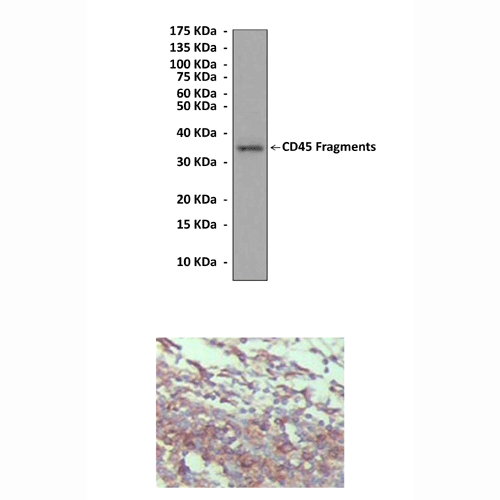Product Sheet CP10045
Description
BACKGROUND CD45 is one of the most abundant leukocyte cell surface glycoproteins and is expressed exclusively upon cells of the hematopoietic system. Different isoforms of CD45 are generated by alternative splicing and are expressed in cell type-specific patterns on functional subpopulations of lymphocytes. In a major advance, CD45 was identified as one of the first members of a novel class of enzymes, the Protein Tyrosine Phosphatases (PTPs). This serendipitous discovery linked CD45 to the process of reversible protein tyrosine phosphorylation, a key regulatory mechanism for controlling the growth and division of eukaryotic cells. CD45 is now established as a critical component of the signal transduction machinery of lymphocytes. In particular, evidence from genetic experiments indicates that CD45 plays a pivotal role in antigen-stimulated proliferation of T lymphocytes and in thymic development.1 Two members of the Src-family of protein tyrosine kinases (PTKs), the p56lck and p59fyn proteins, have been implicated as physiological substrates of CD45, providing an important clue to how the action of this leukocyte-specific PTP might influence signaling by the T cell antigen receptor.2 It is now known that CD45 also modulates signals emanating from integrin and cytokine receptors.3
Structure-function analysis of CD45 and other PTPs has identified structural features of PTP catalytic domains required for enzymatic activity. However, despite intensive efforts, little is known about how the activity of CD45 is regulated. The external domain of CD45 does not appear to be absolutely required for signal transduction by the T cell receptor, and there is currently no evidence that ligand binding modulates CD45 activity. Analysis of CD45 isoform expression has revealed a hitherto unrecognized plasticity in isoform usage by T cells and other leukocytes, adding to the regulatory complexity of isoform expression.4 It is well acknowledged that CD45 affects cellular responses by controlling the relative threshold of sensitivity to external stimuli. Perturbation of this function may contribute to autoimmunity, immunodeficiency, and malignancy. Moreover, recent advances suggest that modulation of CD45 function can have therapeutic benefit in many disease states.
Structure-function analysis of CD45 and other PTPs has identified structural features of PTP catalytic domains required for enzymatic activity. However, despite intensive efforts, little is known about how the activity of CD45 is regulated. The external domain of CD45 does not appear to be absolutely required for signal transduction by the T cell receptor, and there is currently no evidence that ligand binding modulates CD45 activity. Analysis of CD45 isoform expression has revealed a hitherto unrecognized plasticity in isoform usage by T cells and other leukocytes, adding to the regulatory complexity of isoform expression.4 It is well acknowledged that CD45 affects cellular responses by controlling the relative threshold of sensitivity to external stimuli. Perturbation of this function may contribute to autoimmunity, immunodeficiency, and malignancy. Moreover, recent advances suggest that modulation of CD45 function can have therapeutic benefit in many disease states.
REFERENCES
1. Trowbridge, I.S. & Thomas,M.L.: Ann. Rev. Immunol. 12:85-116, 1994
2. Guttinger, M. et al: Int. Immunol. 4:1325-301992
3. Hermiston, M.L. et al: Ann. Rev. Immunol. 21:107-131, 2003
4. Ledbetter, J.A. et al: Curr. Opin. Immunol. 5:334-40, 1993
2. Guttinger, M. et al: Int. Immunol. 4:1325-301992
3. Hermiston, M.L. et al: Ann. Rev. Immunol. 21:107-131, 2003
4. Ledbetter, J.A. et al: Curr. Opin. Immunol. 5:334-40, 1993
Products are for research use only. They are not intended for human, animal, or diagnostic applications.
Details
Cat.No.: | CP10047 |
Antigen: | Purified recombinant human CD45 protein fragments expressed in E. coli. |
Isotype: | Mouse IgG1 |
Species & predicted species cross- reactivity ( ): | Human |
Applications & Suggested starting dilutions:* | WB 1:1000 IP n/d IHC 1:200 - 1:1000 ICC n/d FACS n/d |
Predicted Molecular Weight of protein: | 180 - 220 kDa |
Specificity/Sensitivity: | Detects endogenous CD45 proteins in normal cell lysates without cross-reactivity with other family members. |
Storage: | Store at -20°C, 4°C for frequent use. Avoid repeated freeze-thaw cycles. |
*Optimal working dilutions must be determined by end user.
Products
| Product | Size | CAT.# | Price | Quantity |
|---|---|---|---|---|
| Mouse Cluster of Differentiation 45 Antibody: Mouse Cluster of Differentiation 45 Antibody | Size: 100 ul | CAT.#: CP10047 | Price: $413.00 |

